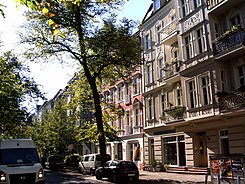Heynstrasse
| Heynstrasse | |
|---|---|
| Street in Berlin | |
| View from Florastrasse southwards into Heynstrasse | |
| Basic data | |
| place | Berlin |
| District | Pankow |
| Created | in the 1890s |
| Connecting roads | Maximilianstrasse, Neue Schönholzer Strasse |
| Cross streets | Florastraße, Florapromenade (east), Brehmestraße (west) |
| Buildings | Buildings |
| use | |
| User groups | Road traffic |
| Technical specifications | |
| Street length | 370 meters |
The Heynstraße is a traffic route in Berlin 's Pankow district in the town district. It was laid out in the second half of the 19th century and, in addition to a larger factory, accommodated tradespeople on connected smaller farms.
location
Heynstrasse runs between Florastrasse and the former route of the Szczecin Railway . In north-south direction, it connects Florastraße with Brehmestraße, which is swung to the east. Remnants of an earlier allotment garden have been preserved on both sides along its southern section, which is around 60 meters long. The eastern side of the street is built on from the bent Florapromenade to Florastraße with connected rows of houses in the Wilhelminian style , opposite on the western side there are rows of residential buildings about half the length of the street. The areas adjoining to the south house commercial yards. The houses are numbered in horseshoe form from number 1 on Florastraße southwards to 19, then northwards back to number 36.
history
Fritz Heyn , a factory owner and deputy mayor in Pankow for a few years, used the profits from his factory to buy large areas in what was then the Berlin suburb, had them parceled out and leased. Previously (1890) Heyn had his dwelling in the Florastraße 23-26 and its production facility for seat tubes ( Peddigrohre ) was located next to it, in the Flora 20-22.
When Heynstraße was shown in the Berlin address book for the first time in 1893, there were only five completed buildings and the commercial yard with the “Stuhlrohrfabrik Heyn & Co.” (house numbers 10–15), all other house numbers are shown as “construction sites”. In 1900 Fritz Heyn still owned 23 pieces of land, including the owner-occupied house (house number 8) and the factory on several areas. Fritz Heyn's contribution to the development of Pankow must have been valued highly by the community, because the street was named during his lifetime.
Buildings (selection)
Numerous buildings and courtyards that have been protected as cultural monuments since the beginning of the 21st century have been preserved in this street from the initial development . Behind Heyn's former residential villa (number 8) there is a garden courtyard with an arbor, fountain and garden sculptures, completed around 1900. During the GDR era, the "Pankower District Chronicle" with the local history collection was established in the house and used the premises until 1989. Since the move of the Chronicle and Collection (renamed in 2001 to "Freundeskreis der Chronik Pankow eV") to Dietzgenstrasse 42 in the district of Niederschönhausen , the Heynstrasse building has belonged to the Pankow Museum Association . You can see the home-style living area of the Heyn family on the first floor, and there are changing special exhibitions on the ground floor.
The factory premises at Heynstrasse 10–15 became known as Heynhöfe . Other manufacturers had already settled on the site in the 1920s, such as the Rauchfuß company, which produced measuring tools, and the Maschinenfabrik Sperling & Co. The municipality of Pankow had acquired parcels 9–12 from Heyn and had houses built here.
The single-storey brick buildings of the commercial courtyards should first be torn down after the fall of the Wall , which was prevented by the district office and committed citizens who founded the Heynhöfe GbR for administration. The Berlin Monument Authority has included the courtyards in its list. The buildings on the courtyards are now being used by several traders, including a central theater service that dyes and prints fabrics for theaters and film production companies from all over the world. Furthermore, the Heynstudios, designers , marketing experts, artists, craftsmen and, since November 2015, a “bar-café”, which took the name of Fritz Heyn, can be found on the courtyards. At the end of 2015, around 30 people were working on the Heynhöfen. Other companies like Dr. Oetker and Toyota have expressed their interest in renting buildings on the farms.
Heynstrasse 21-24 is a building block from 1910, which was built as a residential area and has a spacious inner courtyard. Parcels 21 to 30 were previously owned by the Heyn family of manufacturers.
Web links
- Heynstrasse. In: Street name lexicon of the Luisenstädtischer Bildungsverein (near Kaupert )
Individual evidence
- ↑ Heyn, Fritz . In: Berliner Adreßbuch , 1891, I, p. 498.
- ^ Residents by trade> Fritz Heyn & Co. In: Berliner Adreßbuch , 1891, III, p. 955.
- ↑ Heynstrasse . In: Berliner Adreßbuch , 1893, V, p. 117.
- ↑ Heynstrasse . In: Address book for Berlin and its suburbs , 1900, V, p. 140.
- ↑ Heynstraße 8 garden monument
- ↑ Homepage Pankower Chronik ( Memento of the original from December 19, 2015 in the Internet Archive ) Info: The archive link was inserted automatically and has not yet been checked. Please check the original and archive link according to the instructions and then remove this notice. , accessed December 16, 2011
- ↑ Apartment building next to chair tube manufacture . In: Pankow. Innovative • Creative • Active , 2011 edition, aperçu * publishing company in cooperation with the Pankow District Office (economic development), p. 85.
- ↑ Heynstrasse 9–12 and 13–15 . In: Berliner Adreßbuch , 1921, IV, p. 228.
- ↑ Iris Brennberger: Colorful fabrics, smoky whiskey . In: Berliner Zeitung , 28./29. November 2015, p. 17.
Coordinates: 52 ° 33 ′ 50 ″ N , 13 ° 24 ′ 10 ″ E
